Indications of an Achaea sp. caterpillar outbreak disrupting fruiting of an ectomycorrhizal tropical tree in Central African rainforest
IF 1.1
4区 生物学
Q3 PLANT SCIENCES
引用次数: 0
Abstract
Background and aims – Where one or several tree species come to dominate patches of tropical forest, as many masting ectomycorrhizal legumes do in Central Africa, ecological theory predicts they may be prone to herbivory, which might alter their reproductive output. This was indirectly investigated in lowland rainforest in Cameroon for Tetraberlinia korupensis , whose crowns were attacked in 2008 by an outbreaking black caterpillar—identified as an Achaea sp., probably A. catocaloides —in Korup National Park. Material and methods – Field-collected data on tree-level seed and fruit (pod) production of T. korupensis in its 2008 masting event were compared with that of its two co-dominant neighbours ( T. bifoliolata , Microberlinia bisulcata ), whose populations masted in 2007 (and 2010). To do this, bivariate regression models (linear, polynomial, ZiG [zero-inflated gamma model]), contingency table analysis, and non-parametric measures of dispersion were used. Key results – Assuming T. korupensis is prone to Achaea caterpillar attacks, empirical data support the hypothesized lower proportion of adults participating in its masting (54% in 2008) than for either masting population of M. bisulcata (98% in 2007, 89% in 2010) or T. bifoliolata (96% in 2007, 78% in 2010). These fruiting T. korupensis trees were about one-third larger in stem diameter than conspecific non-fruiters and produced as many pods and seeds per capita as T. bifoliolata . However, regressions only modestly support the hypothesis that the positive tree size–fecundity relationship for T. korupensis was weaker (i.e. lower adj. R 2 ) than for M. bisulcata (whose leaves are morphologically similar) or T. bifoliolata , with mostly similar dispersion about the median among these species. Conclusion – Altogether, the findings suggest a role for tolerance in nutrient-poor forests. It is postulated that instead of conferring resistance to herbivores, the ectomycorrhizas associated with these trees may enable them to more quickly recover from potential yet unpredictable insect outbreaks.在中非雨林中,一种亚纲毛虫爆发,破坏了一棵外生菌根热带树的果实
背景和目的——在一种或几种树木在热带森林中占据主导地位的地方,就像许多生长在中非的外生菌根豆科植物一样,生态学理论预测它们可能倾向于食草,这可能会改变它们的繁殖产量。在喀麦隆的低地雨林中,对koruptetraberlinia korupensis进行了间接调查。2008年,Korup国家公园爆发了一种黑色毛毛虫,被鉴定为Achaea sp.,可能是A. catocaloides。材料和方法:在2008年树龄阶段,将田间收集的korupensis树级种子和果实(荚果)产量数据与2007年(和2010年)树龄阶段的两个共同优势邻居(T. bifoliolata, Microberlinia bisulcata)进行了比较。为此,使用了双变量回归模型(线性、多项式、ZiG[零膨胀伽马模型])、列联表分析和非参数离散度量。关键结果——假设korupensis容易受到Achaea毛虫的攻击,经验数据支持这样的假设,即参与其捕食的成虫比例(2008年为54%)低于双足棘足螨(2007年为98%,2010年为89%)或双叶棘足螨(2007年为96%,2010年为78%)。这些结果树的茎粗比同株不结果树的茎粗大三分之一,人均荚果和种子产量与双叶树相当。然而,回归仅适度地支持这样的假设,即树形大小与繁殖力的正相关关系较弱(即较低的adj. R 2),而叶片形态相似的水杨或双叶树的树形大小与繁殖力的正相关关系在这两个物种之间的分布中值基本相似。结论:总的来说,这些发现表明了在营养贫乏的森林中耐受性的作用。据推测,与这些树木相关的外生菌根可能使它们能够更快地从潜在的但不可预测的昆虫爆发中恢复过来,而不是赋予对食草动物的抵抗力。
本文章由计算机程序翻译,如有差异,请以英文原文为准。
求助全文
约1分钟内获得全文
求助全文
来源期刊

Plant Ecology and Evolution
PLANT SCIENCES-
CiteScore
2.20
自引率
9.10%
发文量
27
审稿时长
>12 weeks
期刊介绍:
Plant Ecology and Evolution is an international peer-reviewed journal devoted to ecology, phylogenetics and systematics of all ‘plant’ groups in the traditional sense (including algae, cyanobacteria, fungi, myxomycetes), also covering related fields.
The journal is published by Meise Botanic Garden and the Royal Botanical Society of Belgium.
 求助内容:
求助内容: 应助结果提醒方式:
应助结果提醒方式:


